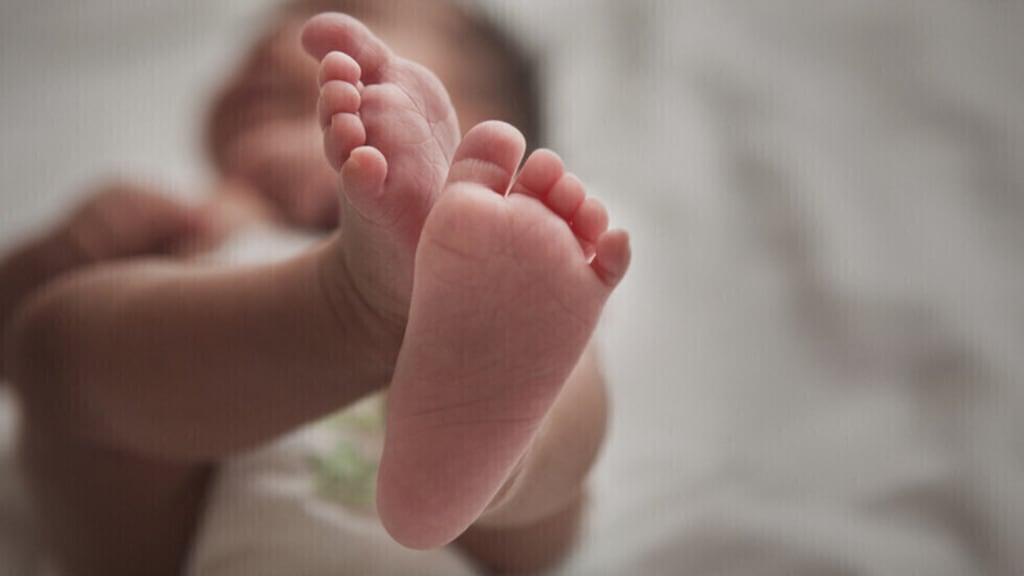The removal of an "embryo" from the skull of his one-year-old sister
Doctors have managed to surgically remove a twin fetus from the skull of his one-year-old sister, in a medical anomaly that has only been recorded a handful of times.

Doctors said the fetus had developed upper limbs, bones and even nails, meaning it likely continued to grow for months while it was inside its sister in the womb.
The fetus, which was about four inches long, was only discovered when the parents took their daughter to hospital for check-ups because she was suffering from an enlarged head and problems with motor skills.
The rare condition is known as "fetus-in-fetus," a medical term that describes a birth defect in which twins fuse together in the womb and one develops physically inside the other.
Only about 200 cases have been documented, of which 18 occurred inside the skull. The presence of a fetus inside a fetus was also discovered in the pelvis, mouth, intestines and even the scrotum.
This condition occurs due to the incomplete separation of identical twins, which are formed when one egg is divided. Doctors don't know exactly how this happens.
Some have hypothesized that a healthy twin connects to the mother via the placenta, while others attach themselves to the twin's blood vessels.
As the older twin grows, the smaller one is sucked into the abdomen. Other scientists have suggested that it occurs as a result of delayed cell division.
A nonviable fetus may continue to develop for several weeks and months inside its sibling, even forming organs, bones and limbs.
In fact, this rare condition was revealed in December in the Journal of Neurology of the American Academy of Neurology.
The unnamed child was taken to hospital after she developed problems with her motor skills.
Doctors did not share any other details of her condition, but this may include problems walking or sitting.
CT scans revealed that the parasitic twin had put pressure on his sister's brain, and that she was also suffering from hydrocephalus, a buildup of fluid deep in the brain that can cause an enlarged head, extreme drowsiness and seizures.
Although the parasitic twin, a few centimeters in size and made up of vital cells, continued to survive a year after birth because it shared a blood supply with its sister, the deformed fetus could in no way survive outside of it. The host twin because he has no brain or heart. Source: Daily Mail
The death of a woman after a rare case in which she carried a "stone child" for 9 years
A woman has died of severe malnutrition after it was discovered she had a condition called "stone child" that obstructed her intestines.
Doctors described the rare case of a 50-year-old Congolese woman, who had been carrying a "calcified fetus" or "petrified fetus", (lithopedion), or as it is also known as the "stone child", in her body for nine years.
The "stone baby" is defined as a rare phenomenon that occurs starting from 14 weeks of pregnancy, when the fetus dies during abdominal pregnancy, and is too large to be reabsorbed by the body, and thus calcified from the outside as part of a strange reaction that protects the mother's body from the dead tissue of the fetus and prevents infection.
The unnamed refugee, who recently arrived in the United States, went to the hospital complaining of stomach cramps, indigestion and a gurgling sensation after eating.
Soon, x-rays revealed a stillborn 28-week-old fetus lodged in her lower abdomen, which was pressing on her intestines.
However, the woman refused to have surgery to remove the lump.
Writing in the journal Medical Case Reports, the doctors said the patient believed her condition was linked to a "spell" someone had cast on her in Tanzania.
Nine years ago, when she first realized she had lost her child, doctors in a refugee camp accused the mother of "evil deeds", "killing her child" and "using drugs".
This left her afraid of doctors, and she has since refused medical treatment.
The woman assured the US medical team that "she will inform them when she is ready for surgery and is not afraid of death."
But just 14 months later, she died of malnutrition after the fetus prevented her intestines from absorbing vital nutrients.
Doctors said the case highlighted the negative impact of "mistrust in medicine" and the need for a better model of care "to bridge the gap between the healthcare team and newly resettled refugees".
They also encouraged doctors to "gain more knowledge about this rare condition."
According to a 1996 paper published in the Journal of the Royal Society of Medicine, only 290 cases of "calcified fetus" have been documented in the medical literature, the oldest of which was the case of a 68-year-old French woman, Ms. Colomb-Chatry.
Her body was autopsied after her death in 1582, and it was found that she was carrying a fully developed fossilized baby in her abdominal cavity.
Chhatri, whose stomach was said to have been "swollen, hard and painful all her life", had been carrying her stone child for 28 years.
In 2009, doctors extracted from a Chinese woman named Huang Yijun, 92, a calcified fetus that she had been carrying for more than half a century.
In 2013, an elderly Colombian woman was shocked when she went to the doctor for pelvic pain and was told the pain was caused by a 40-year-old "stone child". Source: The Sun
A Russian doctor identifies the symptoms of uterine tumors
Dr. Ilona Dovgal, a specialist in gynecology and cancer, revealed the symptoms that indicate the presence of tumors in the uterus.
In an interview with the "Izvestia" newspaper, the specialist indicated that uterine tumors are the most common type of benign tumor in the female reproductive system. The incidence of it reaches 70 percent in childbearing age. This type of tumor is usually discovered at the age of 32-34 years. But doctors discover it at the present time in women under 30 years of age.
She says, "The cause of uterine fibroids is an imbalance of steroid hormones: estrogen and progesterone. In addition, it was confirmed that 5-10 percent of the detected cases are hereditary."
The specialist points out that there are no clear symptoms of this tumor, so it is diagnosed by chance. It is usually diagnosed when women refer to medical professionals regarding pregnancy planning or prevention.
"The clinical symptoms that indicate fibroids are abnormal uterine bleeding, anemia, lower abdominal pain, and dysfunction of nearby organs such as bladder or defecation," she says.
And she adds: "First - a disruption of uterine bleeding can lead to severe anemia. In addition, the tumor can develop into a sarcoma (a malignant tumor) that causes many life problems."
According to her, there are no special ways to prevent uterine polyps.
She explains, "If the tumor is asymptomatic and the woman does not suffer from problems such as anemia or bleeding, she is advised to see a specialist doctor once every six months, just like a healthy woman. During this review, the woman undergoes an ultrasound, blood analysis, hormones, and a tumor smear." And the plant."
In some cases, the doctor can prescribe certain medications to treat the tumor. But when it is large, it must be surgically removed. In most cases, this operation is performed using laparoscopy, which allows the tumor and nodes to be removed from different places in the uterus at the same time, and then to restore the uterine muscles by suturing one layer after another. Source: newspaper "Izvestia"
"The Realistic Sleeping Beauty" British woman sleeps 22 hours a day
A British woman has dubbed herself the "real-life Sleeping Beauty" because of an unusual disorder that makes her sleep 22 hours a day.
The woman suffers from idiopathic hypersomnia, a rare sleep disorder that causes patients to feel "extremely sleepy during the day even after a full night of good sleep," according to the Mayo Clinic.
Joanna Cox, 38, from Castleford in West Yorkshire, once slept for four days without waking due to idiopathic hypersomnia.
She was diagnosed after years of excessive sleep and struggled to stay awake during the day. This often results in a struggle with waking up feeling 'uneasy' and 'mental fog'.
The sleep disorder means Joanna "never feels well" and often sleeps between 18 and 22 hours a day.
Prior to her diagnosis, Joanna found herself sleeping in unusual places, including behind the wheel of a car. She even once skipped a holiday to Spain with her daughters Caitlin, 20, and Isabel, 18, and lives on protein shakes and takeaway meals because she's "quick" in eating them before she goes to bed again.
She also suffers from "severe hallucinations" while struggling to stay awake and has recurring visions of "hundreds of spiders crawling" on her bed.
Joanna ended up in the hospital with low blood sugar after spending four days sleeping without getting up to eat.
Although she does not know the cause of the condition she was diagnosed with in October 2021, she is desperate to find a doctor who can help her manage her symptoms.
Joanna, who is currently unemployed, said: "This condition is really ruining my life. I'm like a real-life 'Sleeping Beauty'. I can't wake up once I fall asleep, I can't work, I can't drive, I can never make any plans because I don't know what's going on." "If I would be awake. I wake up and I don't know what day it is or how long I've been sleeping. It's a loner I'm in and I really need some help."
Joanna started experiencing symptoms in 2017 when she noticed she was feeling very tired during the day. She owned her own cleaning company and struggled to get through the day without resting and eventually taking a nap.
Over the next few years, she went to the general practitioner in an attempt to relieve her stress.
She indicated that the doctors initially thought she was suffering from depression, so she was referred to a mental health specialist. But this hypothesis was ruled out because she had no signs other than fatigue.
She indicated that she underwent many examinations on suspicion of infection or multiple sclerosis and even cancer, but that "no one could diagnose my condition and it was getting worse with the passage of time. In the end, I had to leave my job in 2019."
After speaking with many different psychologists, Joanna was eventually referred to the sleep clinic at Pontefract Hospital, Yorkshire in October 2021, where she was monitored overnight and formally diagnosed with a rare idiopathic sleep disorder.
The condition has continued to worsen over the years and Joan now struggles to stay awake for a few hours a day.
Interestingly, the only time she wakes up from excessive sleep is in the early morning, around 2am, which is when she is walking her two cockapoo dogs.
Joanna, who lives alone, said she would not be able to survive without the support of her daughters, who visit her regularly to check on her and take the dogs outside to walk her if she doesn't wake up.
Unfortunately, the cause of this condition is still unknown, which means that there is currently no treatment. Not to mention, she's tried dozens of treatments to no avail. Source: The Independent
About the Creator
News Correct
Information WorldWide MORE INFORMATION
Enjoyed the story? Support the Creator.
Subscribe for free to receive all their stories in your feed. You could also pledge your support or give them a one-off tip, letting them know you appreciate their work.






Comments
There are no comments for this story
Be the first to respond and start the conversation.